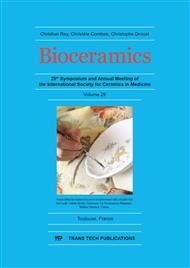[1]
MN Rahaman, DE Day, BS Bal, Q Fu, SB Jung, LF Bonewald, et al, Bioactive glass in tissue engineering, Acta Biomaterialia. 7( 2011) 2355–73.
DOI: 10.1016/j.actbio.2011.03.016
Google Scholar
[2]
MR Day, Bioactive glass stimulates the secretion of angiogenic growth factors and angiogenesis in vitro, Tissue Eng. 11 ( 2005) 768–77.
DOI: 10.1089/ten.2005.11.768
Google Scholar
[3]
A. Arkudas, A Balzer, G Buehrer, I Arnold, A Hoppe, R Detsch, et al, Evaluation of angiogenesis of bioactive glass in the arteriovenous loop model, Tissue Eng Part C Methods. 19 (2013) 479–86.
DOI: 10.1089/ten.tec.2012.0572
Google Scholar
[4]
D Zhang, E Munukka, L Hupa, H Ylänen, MK Viljanen, M Hupa, Factors controlling antibacterial properties of bioactive glasses, Key Engineering Materials. (2007) 173-176.
Google Scholar
[5]
R. B. Gustilo, R. M. Mendoza, and D. N. Williams, Problems in the management of type III (severe) open fractures: a new classification of type III open fractures, Journal of Trauma. 8 (1984) 742–746.
DOI: 10.1097/00005373-198408000-00009
Google Scholar
[6]
O Leppäranta, M Vaahtio, T Peltola, D Zhang, L Hupa, H Ylänen, JI Salonen, MK Viljanen, E Eerola, Antibacterial effect of bioactive glasses on clinically important anaerobic bacteria in vitro, J Mater Sci: Mater Med. 19(2) (2008; ) 547-551.
DOI: 10.1007/s10856-007-3018-5
Google Scholar
[7]
S Begum, WE Johnson, T Worthington, RA Martin, The influence of pH and fluid dynamics on the antibacterial efficacy of 45S5 Bioglass, Biomed. Mater. 11 015006 https: /doi. org/10. 1088/1748-6041/11/1/015006.
DOI: 10.1088/1748-6041/11/1/015006
Google Scholar
[8]
http: /www. bonalive. com/media/uploads/documents/ortho-clinical-cases-brochure_91316f_4_ 27. 1. 2015_print_extract.
Google Scholar
[9]
VV Välimäki, HT Aro, Molecular basis for action of bioactive glasses as bone graft substitute, Scandinavian Journal of Surgery. 95(2) (2006) 95-102.
DOI: 10.1177/145749690609500204
Google Scholar
[10]
C Loty, JM Sautier, MT Tan, M Oboeuf, E Jallot, H Boulekbache, D Greenspan, N Forest, Bioactive glass stimulates in vitro osteoblast differentiation and creates a favorable template for bone tissue formation, J Bone Miner Res. 16 (2001) 231–239.
DOI: 10.1359/jbmr.2001.16.2.231
Google Scholar
[11]
M Bosetti, M Cannas, The effect of bioactive glasses on bone marrow stromal cells differentiation, Biomaterials. 26 (2005) 3873–3879.
DOI: 10.1016/j.biomaterials.2004.09.059
Google Scholar
[12]
ID Xynos, AJ Edgar, LD Buttery, LL Hench, JM Polak, Ionic products of bioactive glass dissolution increase proliferation of human osteoblasts and induce insulin-like growth factor II mRNA expression and protein synthesis, Biochem Biophys Res Commun. 276 (2000).
DOI: 10.1006/bbrc.2000.3503
Google Scholar
[13]
L Drago, E De Vecchi, M Bortolin, M Toscano, R Mattina, CL Romanò, Antimicrobial activity and resistance selection of different bioglass S53P4 formulations against multidrug resistant strains, Future Microbiol. 10 (8) (2015) 1293-9.
DOI: 10.2217/fmb.15.57
Google Scholar
[14]
E Munukka, O Leppäranta, M Korkeamäki, M Vaahtio, T Peltola, D Zhang, L Hupa, H Ylänen, JI Salonen, MK Viljanen, E Eerola, Bactericidal effects of bioactive glasses on clinically important aerobic bacteria, J Mater Sci: Mater Med. 19 (1) (2008).
DOI: 10.1007/s10856-007-3143-1
Google Scholar
[15]
CL Romanò, N Logoluso, E Meani, D Romanò, E De Vecchi, C Vassena, L Drago, A comparative study of the use of bioactive glass S53P4 and antibiotic-loaded calcium-based bone substitutes in the treatment of chronic osteomyelitis - a retrospective comparative study, Bone Joint J. 96-B (2014).
DOI: 10.1302/0301-620x.96b6.33014
Google Scholar


